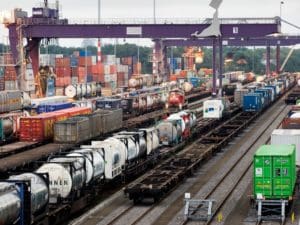The 2017 State of Logistics report shows that in the US the faster and more reliable modes have grown year-over-year. These faster modes are also forecast to continue to grow for the next five years. Slower or less reliable modes – that defines rail freight – have had, and are forecast to continue to have, low or negative growth.

This year parcel and express delivery surpassed rail freight as the second largest sector after motor carriers (the motor carrier category includes truckload, less-than-truckload, and private/dedicated).
| Transportation Spend ($ Billion) |
2016 |
YoY 16/15 |
5-yr. CAGR |
| Truckload |
269.4 |
-1.6% |
4.3% |
| Less-than-truckload |
58.0 |
0.5% |
-1.2% |
| Private or Dedicated |
268.1 |
0.7% |
5.7% |
| Parcel |
86.3 |
10.0% |
6.4% |
| Rail |
71.9 |
-11.0% |
-1.1% |
| Air Freight |
66.9 |
1.5% |
2.4% |
| Water |
40.6 |
-10.0% |
-0.1% |
Rail is a low-cost mode, but it is slow. Here are statistics from September of 2017 on the performance of several of the Class 1 rail providers in North America.
| Railroad |
Train Speed |
Terminal Dwell |
| BNSF |
25.4 |
25.0 |
| Canadian National |
25.5 |
16.2 |
| Kansas City Southern |
27.8 |
20.8 |
| Norfolk Southern |
21.6 |
24.8 |
| Union Pacific |
25.6 |
30.7 |
What approach should freight railroads adopt to enhance the throughput of their freight operations? Technology can be part of the answer. Rail signaling and train control systems have great potential. In the US, there is a mandate to put in Positive Train Control systems; these systems improve safety. Safety is important, but what shippers care about is speed and reliability.
My colleague Pranav Misal has been researching the rail signaling space (ARC recently published his Rail Signaling and Train Control Systems Market Research Study). One interesting solution that drives increased utilization is Communications Based Train Control (CBTC). These signaling systems control the movement of a train by remotely adjusting train speed and braking. More traditional signaling systems were based on RFID along the train track, but wireless train-to-ground signaling is becoming more popular. As freight railroads seek to maximize capacity, there is also an increased need for secure, reliable and fast-paced network connections between moving trains and ground systems.
There are different ways to classify train control systems. One system is known as the European Train Control System (ETCS). In this hierarchical classification system, the Level 2 solutions are the solutions that improve throughput by as much as 25-30 percent.
Rail is a low margin business. In these kinds of businesses, it can be hard to justify large investments. Pranav tells me, switching to ETCS across all three levels is estimated to cost $350,000 to $400,000 per kilometer for track-side and on-board equipment. Still as rail in North America continues to lose market share, and the rail lines seek to better compete against each other, the kinds of throughput gains advanced train control systems can bring surely merit serious attention.



















